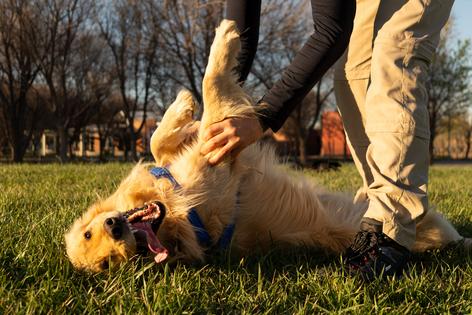My Pet World: Obedience training can help 'stubborn' Golden Retriever get moving
Dear Cathy,
My daughter has a wonderful, 20-month-old Golden Retriever who just loves to play ball and will do so for hours. However, she has developed a stubborn streak. When it’s time to come inside or leave a park, she often refuses. Initially, she would just sit, and you couldn’t coax her to move, even with treats. Lately, she often lays down on her side and “plays dead,” sometimes appearing to be smiling at you as she refuses to move. Obviously, lifting a 70 lb. dog who doesn’t want to move into a car is impossible. Any ideas on how to break this increasingly troublesome behavior? — Howard, Malverne, New York
Dear Howard,
Obedience training is your daughter’s best option. But before I get into that, I want to suggest a quick strategy for the dog park. Your daughter should only take your grand-dog to the dog park when the dog is hungry (so before breakfast or before dinner), so she will respond better to treats. Regular biscuits won’t cut it here. The treats should be high-value, which means extremely flavorful with an intense scent. Pieces of hot dog may work.
Here is how she uses them.
When your daughter prepares to leave the dog park, she should put the dog on a long retractable lead. Whether the dog is standing or laying down, tell her to let the dog smell the treats and then walk away excitedly with them. The dog will still be on the lead, so she will have control of her, but it should alarm the dog that her person is leaving. Hopefully, the dog gets up from either that motivation or the possibility of the high-value treat. If she doesn’t get up and follow her, then she should not take the dog to the dog park until after obedience training.
With obedience training, your daughter should start with the basics (sit, stay, down), but she must train the dog to respond to “let’s go.” The fastest way to do this is to have her carry high-value treats in her pocket and reward the dog whenever the dog is following her. She just needs to say, “let’s go” in an overly excited voice when the dog is moving, say the dog’s marker/reward word (i.e., Bingo) to acknowledge the desired behavior, and then give the dog a high-value treat. If she continues this training for several weeks, the dog should become much more eager to get up and follow her home.
Dear Cathy,
It seems like the majority of your columns that have to do with cats and their behavior issues always begin with the suggestion of using cat pheromone collars and diffusers to help mitigate behavior problems. If cat pheromone products worked that well, you would likely see a noticeable decrease in readers asking for cat behavior advice.
I have tried all of the cat pheromone products to no avail and what readers should know is they can be costly, involve a daily and monthly commitment for use, and may give pet owners unrealistic expectations of helping change an animal’s behavior. In my research of these products, some veterinary journal articles have reported pheromone products can actually have the opposite effect on cats and make things worse.
I think these products should be used as a last resort and instead of suggesting them at the beginning of your columns, you should save them for the end with the disclaimer “pet owners should do their own product research after consulting with their veterinarian.” — Amy, Appleton, Wisconsin
Dear Amy,
I always recommend using pheromones in conjunction with the training, desensitization, or behavior modification advice given; never just on their own. Pheromones do not solve behavior problems, but they may induce a sense of well-being and safety for the animal, which can help them adapt better to change and respond more quickly to training.
While no product ever works the same way for every animal, I have seen positive results with its use and know many veterinarians (including my own) who recommend and even use these products in their practices, which is why I recommend them. I assume this advice is helpful to some pet owners since I receive letters from them telling me they implemented the recommendations, and they’ve had positive outcomes for their pets.
As for the cost, a pheromone collar is about $30. The other pheromone-related products are similar in cost. This outlay is not meant to be ongoing. I recommend using pheromones while retraining an animal (30 to 90 days) or when there are changes happening in the home.
========
(Cathy M. Rosenthal is a longtime animal advocate, author, columnist and pet expert who has more than 25 years in the animal welfare field. Send your pet questions, stories and tips to cathy@petpundit.com. Please include your name, city, and state. You can follow her @cathymrosenthal.)
©2022 Tribune Content Agency, LLC.
(c) 2022 DISTRIBUTED BY TRIBUNE MEDIA SERVICES, INC.












Comments